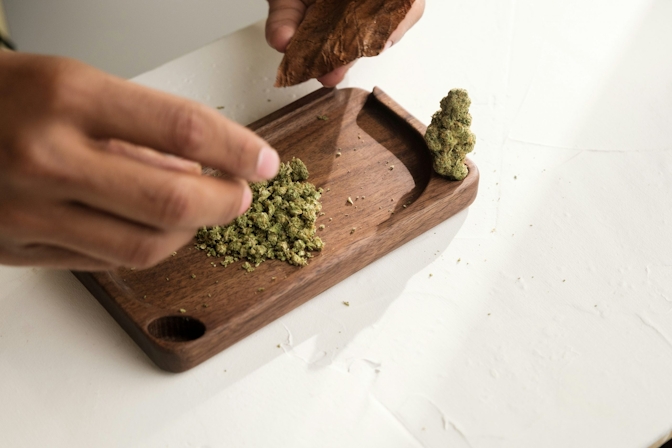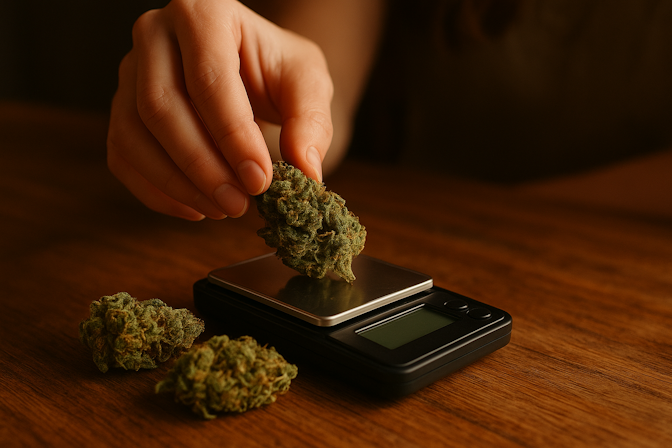
Herb
Weed Math 101: How to Calculate THC Dose, Tolerance, and Budget by the Gram
Plan your stash budget ahead of time by calculating your ideal THC dose.
Understanding “weed math” makes it easier to dose THC, budget for your cannabis needs, and figure out how much flower you need.
Whether you’re microdosing THC for productivity or measuring out a half-ounce to make cannabutter, knowing how much to consume and how to calculate it matters for both cost and effect, especially as dosing guidance becomes more standardized across the cannabis industry.
Key Takeaways

Budding / Unsplash
- THC dosing depends on your tolerance, product type, and how much cannabis you consume.
- You can calculate your THC dose by the gram using this formula: THC% × grams = total THC in milligrams (mg).
- Budgeting for cannabis involves both cost-per-gram math and considering potency across different strains.
- Your tolerance level helps determine what is a low, medium, or high THC dose.
- The most common cannabis measurements include 1 gram, 3.5 grams (eighth), 7 grams (quarter ounce), 14 grams (half-ounce), and 28 grams (one ounce).
- Knowing your THC consumption habits can help you plan ahead, especially for medical patients or regular consumers.
THC Dosing: What's a Safe Amount to Consume?

Smoke Honest
When it comes to THC dosing, there’s no one-size-fits-all number. The ideal amount depends on your body chemistry, tolerance, and chosen consumption method. The goal is to find a dose that delivers your desired effects without overwhelming your system.
Factors That Influence THC Dosing
Tolerance: If you’re new to cannabis or only use it occasionally, your tolerance is likely low. Even small amounts of THC can feel intense. In contrast, daily consumers or medical patients often develop a higher tolerance, requiring more THC to feel the same effects.
Method of consumption: Different consumption methods may require different THC dosing. Smoking, vaping, edibles, tinctures, and THC oil all hit differently. For example, smoking cannabis flower typically hits within minutes and fades faster, while edibles take longer to kick in and last several hours. Each route delivers different levels of THC to your bloodstream, even with the same THC dose.
Product potency: The THC percentage in cannabis flower ranges from around 10% to over 30%. That means a single gram could contain anywhere from 100 to 300 mg of THC. Concentrates and oils can exceed 80% THC, delivering much higher doses per puff or drop.
Desired effects: Are you looking for subtle relaxation, pain management, or intense euphoria? Your intent should guide your dosing decision. Someone microdosing for focus and productivity will need far less than someone trying to treat chronic insomnia.
So, what is a safe amount of THC to consume? For many, a low dose of THC is around 2.5 mg, especially for edibles. A medium dose falls between 5 mg and 10 mg, and what is a high dose of THC? Anything above 20 mg to 30 mg at once can be overwhelming for some.
Can you overdose on THC? Not fatally, but consuming too much could lead to intense anxiety, confusion, or paranoia. Start low and work your way up, especially with edibles or concentrated cannabis oil.
How to Calculate THC Dose by the Gram

Herb
Want to figure out how much THC you’re actually consuming? Here’s how to do it using cannabis flower and simple cannabis math:
THC% × Grams = THC Dose (mg)
Let’s say you have one gram of flower that tests at 20% THC:
- 20% of 1 gram (1,000 mg) = 200 mg THC
- That’s your total potential THC dose in the entire one gram of cannabis flower.
- To get the exact dose per bowl, you’ll need to know how much ground flower you’re smoking. The average bowl size can range from 0.15 g to 0.25 g, which comes out to around 30 mg to 50 mg of THC based on a 20% gram of flower.
Depending on combustion, vaping, or digestion, only a portion of the THC will reach your bloodstream. Still, knowing your THC per gram helps you plan your dose and is especially valuable for medical patients, edible makers, or anyone who needs to follow a precise recipe.
Matching THC Dose to Your Tolerance Level
Your THC dose should match your weed tolerance level, which is something that increases the more you consume. If you are new to cannabis or only use it once in a while, you likely have low tolerance. In that case, a dose between 2.5-5 mg of THC is often enough to feel subtle effects without becoming overwhelmed. This is also the ideal range for people who are microdosing THC, whether for anxiety, focus, or mood support.
If you use cannabis occasionally but not daily, your tolerance may be in the moderate range. A dose between 10 and 25 mg of THC can support a more noticeable experience, relaxation, mild euphoria, or relief from pain or stress, without pushing into heavy intoxication. This range is where many recreational consumers tend to land, especially when using cannabis edibles or low-dose THC oil.
For high-tolerance users, especially daily consumers or medical patients, a typical dose often starts around 25 mg and can exceed 100 mg. These users may require a stronger dose to feel the same level of effect due to how the body adapts over time. However, even in high-tolerance scenarios, many consumers find success with higher-potency cannabis flower, oils, or different strains rather than simply taking more.
Knowing your tolerance helps you avoid overdoing it, reduce THC waste, and stay consistent. If you’re not sure where to start, begin with a low THC dose, track how you feel, and gradually adjust. Always allow enough time, especially with edibles, before deciding to take more.
How to Calculate Your Budget by the Gram

Elsa Olofsson / Unsplash
Start with the basics: if cannabis is $10 per gram and your budget is $100, you can afford 10 grams. Simple weed math, but real-world planning requires a little more thought.
Strain potency can definitely affect how far your stash goes. If you’re choosing between two eighths, one testing at 28% THC and the other at 22%, they might be the same average price per gram, but the higher-THC option might look like the better deal if you’re focused on getting more THC per gram. That said, more THC doesn’t always mean better. Some lower-testing strains hit harder or feel more balanced, especially if they’ve got strong terpenes or a solid mix of other cannabinoids. THC percentage tells part of the story, but not the whole thing.
For consumers who are microdosing or aiming for consistent daily relief, higher-potency cannabis can stretch the budget further, but only if the strain matches their goals.
Measuring out the precise weight of each session, whether using a digital scale or buying pre-measured single grams, also helps you stay consistent. If you’re trying to moderate your THC consumption or make your supply last, weighing each dose can prevent overpacking bowls or wasting flower. It’s especially useful for anyone following a set dosage plan, tracking effects, or infusing flower into recipes that require accurate cannabis measurements.
Prices aren’t just about the cannabis itself; they vary based on where you shop, what brand you’re buying, and how it’s packaged. Some strains cost more simply because they carry a big name or come in fancy jars, even if the THC content isn’t all that different. You’ll also run into taxes at checkout, which can stack up fast. In some states, that $35 eighth could ring up closer to $50. Other places have lower prices, especially for medical users who might not get taxed at all.
Budgeting Strategies Based on THC Consumption Levels

Herb
Your THC budget should reflect how often and how much you consume.
Microdosing (2.5-5 mg THC)
- Best for: Focus, mood boost, clarity
- Weed math: Even a small nug can last days
- Budget: $20 to $40/month
Moderate Dosing (5-25 mg THC)
- Best for: Evening use, stress, sleep
- Weed math: 1 gram of 20% THC flower = ~200 mg THC
- Budget: $50 to $150/month, depending on strain strength and frequency
High Dosing (25+ mg THC)
- Best for: Medical patients, high-tolerance users
- Weed math: A quarter ounce (or seven grams) of high-THC flower could deliver well over 1,000 mg
- Budget: $150 to $300/month or more
To plan your spending:
- Multiply your daily THC dose by the number of days you’re stocking up for.
- Divide the total mg needed by the THC mg per gram of your selected strain.
- Use that to figure out how many grams of cannabis you’ll need, and how much that’ll cost at your local dispensary.
Final Thoughts

Herb
Whether you’re smoking a dime bag, experimenting with edibles, or stocking up on a new strain, understanding the numbers behind THC dosing, budgeting, and common measurements helps you get more out of your sessions.
Measuring and calculating your THC consumption puts you in control, especially with pricing that can change depending on location, product type, or quality. You can use this guide to fine-tune your dosage, manage your costs, and determine the right amount to consume over time.
Herb Recommended Products:
READ MORE










